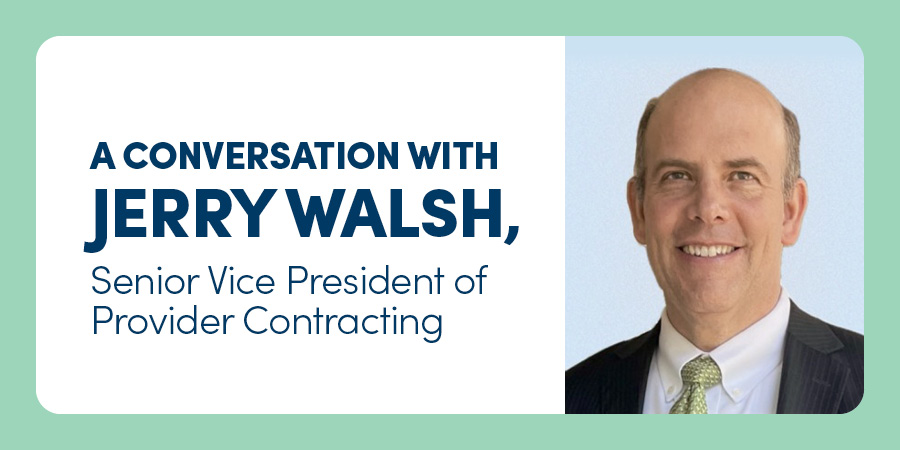

In May, Highmark named Jerry Walsh as Senior Vice President (SVP) of Provider Contracting. Walsh had previously served at Highmark as a SVP, Market Executive, responsible for the overall performance of the Northeastern Pennsylvania and Delaware markets. He has over 25 years of experience in the health care industry managing provider networks, developing dynamic partnerships, and implementing innovative strategies to improve health care delivery.
As SVP of Provider Contracting, Walsh is responsible for managing Highmark’s provider network to deliver market-leading cost and quality outcomes that meet the evolving needs of Highmark’s members.
We sat down with Mr. Walsh to ask him about several topics related to our networks, providers, and reimbursement strategies.
| Q | What are your current priorities and key focus areas within your new role? |
In the short term, my focus is on getting to know the team and understanding their needs. I’m looking at our goals as an organization and what we need to get done over the next three years — ensuring we have the people and capabilities to achieve those goals. I’m also focused on maintaining Highmark’s strategy which is having networks in place that serve the diverse needs of the people we serve — and ensuring that those networks are achieving both the cost and quality transformation goals that we desire as a company.
| Q | What do you believe are the biggest challenges in building and maintaining provider networks? |
I would say the biggest challenge as a health insurance company is balancing that most people we serve, whether that be group customers or individual purchasers, believe they want the broadest network possible because they want choice and they want access to it. But at the same time, they want the lowest cost and the best quality, but sometimes those don’t always go together.
When it comes to network providers, we have to work with likeminded providers who are truly interested in the same things we are, which are improving the member experience, improving the provider experience while managing a better total cost of care and better-quality outcomes. To do that, you must be working together, sharing information, and creating joint solutions.
| Q | How does Highmark ensure its provider partnerships are continually adding value for both network providers and members? |
It’s really been a constant state of evolvement since I started with Highmark in 2015. Highmark is always seeking better ways to work with providers.
We maintain metrics that we use to evaluate our relationships to ensure that we’re delivering a better total cost of care for the populations that are being served — while maintaining or improving quality. We’re also looking at our membership in those markets where we have partnerships to ensure growth and support of those providers.
When we launched Living Health , we really changed our thinking on how to partner with our providers with the goal of transforming care delivery. Today, we have a more diverse team with different backgrounds and perspectives involved in those discussions. We’re bringing together people like me who really understand the health insurance business along with clinicians who have practiced and recognize the needs there. Then, add in technology and the people who are helping to create solutions to improve the experience of our providers and our members. It’s a more collaborative approach.
, we really changed our thinking on how to partner with our providers with the goal of transforming care delivery. Today, we have a more diverse team with different backgrounds and perspectives involved in those discussions. We’re bringing together people like me who really understand the health insurance business along with clinicians who have practiced and recognize the needs there. Then, add in technology and the people who are helping to create solutions to improve the experience of our providers and our members. It’s a more collaborative approach.
| Q | How is Highmark working to improve outcomes and lower costs through its Value-Based Care strategy? |
Highmark has been at the forefront of value-based reimbursement (VBR) starting with our hospitals and health systems over 20 years ago — and more recently with our True Performance program for primary care physicians which was groundbreaking at the time. We continue to expand and improve upon existing programs to address emerging health challenges.
We’re going through a process now to refresh the toolbox. Our goal is to increase the percentage of spend that is covered under value-based care programs versus straight fee-for-service. We’ve been improving that number year over year and will continue to do so. What we’ve also focused on in the last few years is identifying provider partners who are willing to work with us to create a global value-based reimbursement model that creates a higher level of financial, clinical, and analytical alignment. And that’s not always easy to do. We’re running a health plan and they’re running a health system or physician practice. We must find a way to create a balance there — with a focus on better outcomes for the people we serve.
We've been able to stay ahead of the curve, and I think we'll continue to do that.